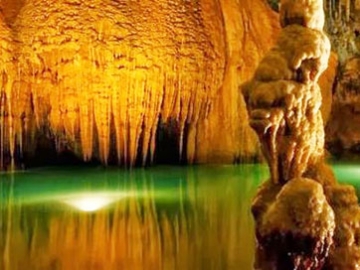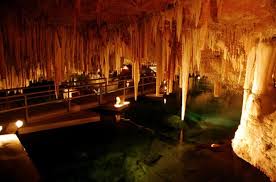 LAS CUEVAS DE BELLA MAR, CUBA, UN REGALO DE LA NATURALEZA MONUMENTAL.
LAS CUEVAS DE BELLA MAR, CUBA, UN REGALO DE LA NATURALEZA MONUMENTAL.
LAS CUEVAS DE BELLA MAR son un conjunto de cavernas de mas de 23 kilómetros de galerias situadas en la provincia Matanzas, Cuba.
Por la belleza de sus galería y cavernas, los importantes hallazgos paleontológicos, además de una amplia gama de procesos cristalinos fueron declaradas Monumento Nacional.
Las galerías y pasadizos de las Cuevas de Bellamar se calcula que comenzaron a formarse hace unos 300 mil años. Según los estudiosos, la planicie en la cual están las cuevas se encontraba originalmente bajo el mar, formando parte de la bahía de Matanzas. A lo largo de la llamada Falla de Bellamar el agua subterránea, en combinación con el dióxido de carbón, fue disolviendo la roca calcárea y de esta forma fue creando cámaras subterráneas en el subsuelo; bajo el fondo marino.
Descubrimiento
Las Cuevas de Bellamar fueron descubiertas por casualidad en febrero de 1861 cuando un esclavo perdió su barreta abriendo un hueco en el suelo, tratando de remover una roca de cal. El esclavo y el mayoral imaginaron que la tierra se había tragado la barreta. Don Manuel Santos Parga, dueño de la finca, pidió explicaciones y al no recibir respuestas se dirigió al lugar de los hechos, ordenó que se cavara allí; y apenas se había abierto un espacio de poco más de una vara, salió por el agujero practicado una gran corriente de aire repugnante de olor; caliente y como humoso; entonces quedó así al descubierto la entrada de la cueva.
El señor Parga, que era entendido en cosas de minas y cuevas, se dio cuenta de lo que el descubrimiento significaba y comenzó a preparar la cueva para que los visitantes pudieran disfrutarla. Sacaron muchas piedras; hicieron escaleras de mampostería que aun están en uso; instalaron pasamanos; y tan pronto fue una realidad, instaló luz eléctrica. Él o uno de los guías bajo su empleo llevaban a los turistas por los pasadizos de la cueva mientras explicaban lo que estaban viendo. Dos años después del acontecimiento, el matancero José V. Betancourt, narró lo sucedido.
Llamadas originalmente las Cuevas de Parga en homenaje a su descubridor, el punto cambió su nombre por el de Las Cuevas de Bellamar, en plural, (aunque los especialistas indican que se trata de una sola cueva con varios salones) debido a su cercanía con la playa homónima en el oeste matancero.
Estalactitas
Las estalactitas son cilíndricas, y según aumenta su tamaño se hacen cónicas mientras que las estalagmitas son cónicas o aplanadas, como derretidas. Ambas crecen hasta unirse y formar columnas. En algunos casos varias estalactitas relativamente cercas se van uniendo, dando lugar a las formaciones llamadas matos. Otras corren próximas a la pared formando cascadas. En las Cuevas de Bellamar se ven todas estas formaciones.
En el salón principal se encuentra la formación rocosa conocida como ‘Manto de Colón’. Esta es la más grande y antigua que se presenta en forma de cascada y tiene una altura de 12 metros. Dividida en cuatro sectores, sus galerías y salones están tapizados de estalactitas, estalagmitas y helictitas, estas últimas de caprichosas formas horizontales.
A las Cuevas de Bellamar se entra es por la cavidad llamada Salón Gótico, una cámara de forma cuadricular que mide unos 80 metros de largo por unos 25 metros de ancho. En la otra dirección se encuentran el pasadizo de Hatuey, Salón de las Damas, Lago de las Dalias y el Baño de la Americana. Sobre esta última existe la leyenda de que una veraneante estadounidense, muchos años atrás, se perdió en ese sitio, cuando decidió refrescar su cuerpo en las cristalinas y frías aguas.
En la centenaria cueva un grupo de espeleólogos descubrieron una estrecha cavidad que los condujo a otra prolongación subterránea de unos nueve kilómetros de longitud. Para sorpresa de todos, encontraron allí galerías de incomparable belleza. Se trata de formaciones cilíndricas pendientes de estalactitas, y suspendidas en el aire, en cuyos extremos cuelgan un conglomerado de cristales macizos de calcita.Por su dimensión y rareza los especialistas consideran el descubrimiento como joya exclusiva, incomparable con ningún otro hallazgo de su tipo. Son formaciones indescriptibles, por cuanto en ningún otro lugar del planeta se conoce semejante cristalería de carbonato de calcio.
Las Cuevas de Bellamar sigue siendo la reina, el centro turístico más antiguo de Cuba, Monumento Nacional, preferida de todos los que la visitan.
 THE CAVES OF BELLA MAR, CUBA, A GIFT OF MONUMENTAL NATURE.
THE CAVES OF BELLA MAR, CUBA, A GIFT OF MONUMENTAL NATURE.
THE CAVES OF BELLA MAR is a group of caverns of more than 23 kilometers of galleries located in the Matanzas province, Cuba.
Due to the beauty of its gallery and caves, the important paleontological findings, in addition to a wide range of crystalline processes, were declared a National Monument.
It is estimated that the galleries and passageways of the Bellamar Caves began to form around 300,000 years ago. According to scholars, the plain on which the caves are located was originally under the sea, forming part of the Matanzas Bay. Throughout the so-called Bellamar Fault, the groundwater, in combination with the carbon dioxide, was dissolving the calcareous rock and thus creating underground chambers in the subsoil; under the seabed.
Discovery
The Bellamar Caves were discovered by chance in February 1861 when a slave lost his bar, opening a hole in the ground, trying to remove a lime rock. The slave and the foreman imagined that the earth had swallowed the bar. Don Manuel Santos Parga, owner of the farm, asked for explanations and when he did not receive answers, he went to the scene, ordered that they dig there; and as soon as a space of little more than a stick had opened, a great current of smelly disgusting air came out of the hole; hot and smoky; The entrance to the cave was thus revealed.
Mr. Parga, who was knowledgeable about mining and caves, realized what the discovery meant and began preparing the cave so that visitors could enjoy it. They took out many stones; they made masonry stairs that are still in use; they installed handrails; and as soon as it was a reality, he installed electric light. He or one of the guides under his employment took the tourists through the passages of the cave while they explained what they were seeing. Two years after the event, José V. Betancourt from Matanzas narrated what had happened.
Originally called the Cuevas de Parga in honor of its discoverer, the point changed its name to Las Cuevas de Bellamar, in the plural, (although specialists indicate that it is a single cave with several rooms) due to its proximity to the eponymous beach in western Matanzas.
Stalactites are cylindrical, and as their size increases, they become conical while stalagmites are conical or flattened, like melted. Both grow to join and form columns. In some cases, several relatively close stalactites unite, giving rise to formations called Matos. Others run close to the wall in waterfalls. In the Bellamar Caves, you can see all these formations.
In the main hall is the rock formation known as ‘Manto de Colón’. This is the oldest and largest waterfall, and it is 12 meters high. Divided into four sectors, its galleries and halls are upholstered in stalactites, stalagmites, and helictites, the latter with whimsical horizontal shapes.
The Bellamar Caves are entered through the cavity called the Gothic Hall, a square-shaped chamber that is about 80 meters long by about 25 meters wide. In the other direction are the Hatuey passageway, the Ladies’ Hall, the Dalias Lake, and the American Bath. About this last one, there is a legend that an American vacationer, many years ago, got lost in that place, when she decided to cool her body in the crystalline and cold waters.
In the centuries-old cave, a group of cavers discovered a narrow cavity that led them to another underground extension about nine kilometers long. To everyone’s surprise, they found galleries of incomparable beauty there. They are cylindrical formations pending from stalactites, and suspended in the air, at the ends of which hang a conglomerate of solid calcite crystals. Due to their size and rarity, the specialists consider the discovery as an exclusive jewel, incomparable with any other finding of its kind. They are indescribable formations because nowhere else on the planet is such calcium carbonate glassware known.
Las Cuevas de Bellamar is still the queen, the oldest tourist center in Cuba, National Monument, preferred by all who visit it.
Agencies/ Wiki/ Ecured/ Internet Photos/ Arnoldo Varona/ www.TheCubanHistory.com
THE CUBAN HISTORY, HOLLYWOOD.
Fuentes










